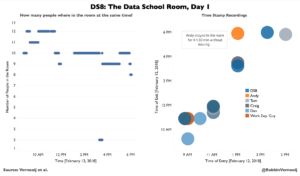1st day, 1st blog – reaching the data school and tackling timestamp data in Tableau.
1. Reaching the Data School Day 1
Having survived my first day at the data school (DS8), I felt like sharing a few moments, which ultimately led me to this day.
Working with large data sets over the years, I had tried to script as much as possible in order to create a setup where everything would work, no matter the format. As expected, however, this wasn’t reality and I ended up having to re-write and re-do a lot of graphs in order to make them presentable.
I first got in contact with Information Lab at a career event, hosted at the University of Warwick. Convinced by their people, but sceptical about the software, I ended up at a meet & great where I could see the power of both Alteryx and Tableau.
However, the people at the Information Lab & the Data School were the ones that convinced me the most. A whole bunch of people with a large variety of backgrounds and yet I felt like they all share the same drive to engage with any type data, and make it work, for themselves or others.
Applications, interviews, offer and now I’m here! (A different and exciting way of interviewing)
The data school managed to live up to my expectations on day 1; organised, prepared, directly on to business and a warm welcome by everyone (online and offline).
2. A bit of Tableau: Start date & End date – translation into
The 4 months of training have started, and it is likely that we will spend most of our days in the infamous Data School Training Room. I ended up collecting timestamps of people/groups entering and leaving the room on day 1, out of curiosity, to have a look at it in Tableau later.
When I initially imported the data into Tableau I ran into a problem, how do I convert timestamps of entry/exit to actual time spend in the room?!
I quickly ended up finding a post from the Tableau Community tackling this problem (method from Deepak Rai, thanks!):
By filtering the periods and adding a calculated field, the number of records (i.e., people) can be added up to cover, in this case, each minute.
Interactive viz: goo.gl/npFQrJ
That’s it for now, more data blogs to follow!

